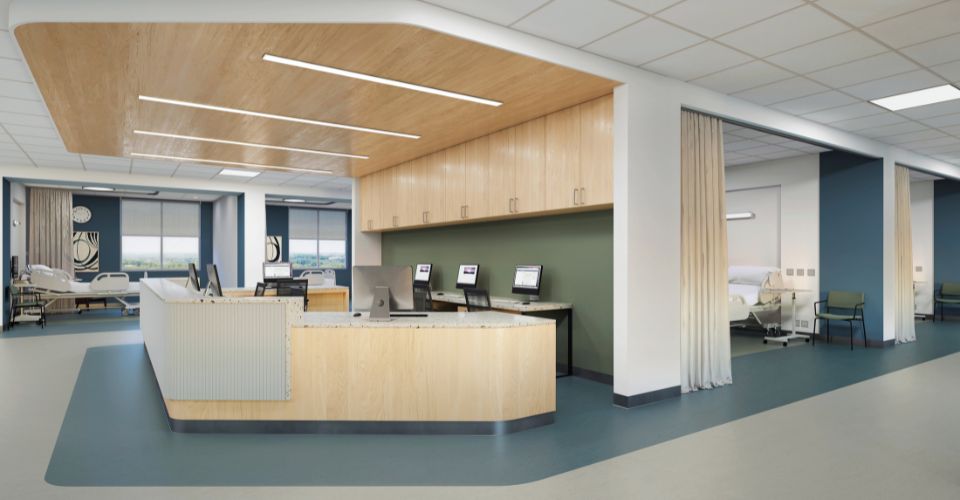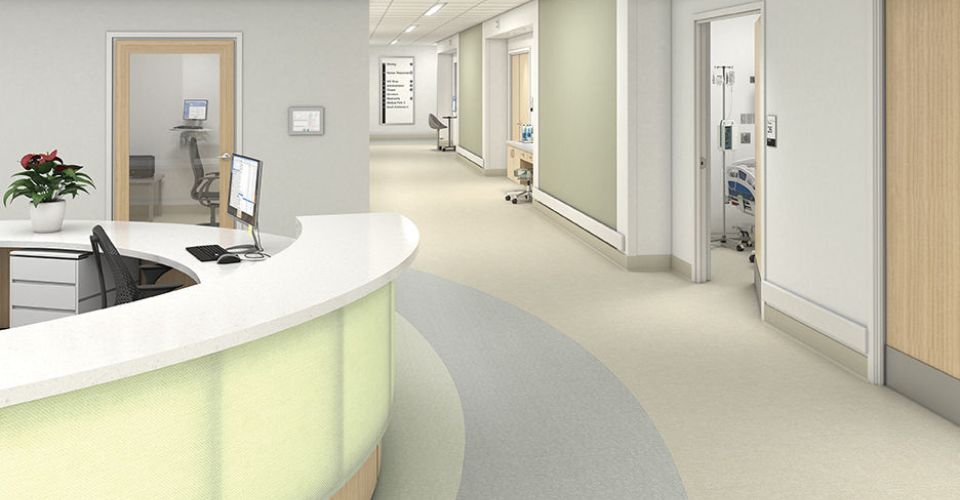When it comes to designing healthcare facilities, evidence-based design — making design decisions based on research about how aspects of the physical environment directly influence human performance and wellbeing — is the go-to approach informing the creation of today’s healing spaces, and this in turn influences healthcare flooring selection.
Because flooring is the largest surface in any healthcare facility, it represents a significant and versatile opportunity to further space-specific goals through thoughtful material selection. When facilities rely upon an evidence-based design process, they create healthcare spaces that successfully support improved patient outcomes, acoustics, underfoot comfort and infection control, while prioritizing the patient and caregiver experience with a goal of achieving a return on their investment.
The Center for Healthcare Design has identified eight performance characteristics of evidence-based design flooring that define the impact flooring has on operations, health, safety, and wellness. Let’s look closer at the importance of considering these attributes when specifying flooring to create supportive spaces.
1. Reduce slips, trips, and falls
Every year, an estimated 700,000 to one million hospital patients suffer from falls, resulting in injuries that can have life-threatening consequences, particularly for elderly patients. The right flooring can significantly reduce the number and severity of falls in several ways.
- Dense materials, like rubber, provide more friction and improve traction for patients, staff, and rolling equipment.
- Continuous flooring removes the need for transition strips, making it easier to transport rolling equipment and navigate with wheelchairs.
- Softer surfaces like rubber and carpet can reduce the impact of falls and the severity of injuries.
Impaired visual acuity is also a concern for trips and falls, especially in elderly care. Busy patterns and glare from waxed surfaces can make navigating a space difficult. When selecting healthcare flooring, it’s best to:
- Avoid flooring with medium-sized patterns. Research has found that flooring with patterns ranging from 1 to 6 inches had higher fall rates compared to those outside that range.
- Use finishes that reduce glare. Waxed finishes can result in harsh glare from fluorescent lights and require additional maintenance.
2. Reduce patient and staff injury
Onsite injuries that involve staff or patients can have a steep economic impact. Thankfully, flooring can be used as both a preventative and proactive measure against injury in the following ways:
- Provides firmness and stability to prevent trips and loss of balance
- Reduces rolling resistance to minimize manual wheelchair pushing effort
- Mitigates infection control issues
- Reduces musculoskeletal injury
3. Reduce noise levels
The World Health Organization recommends that noise levels remain between 30-35 dB in healthcare settings. There is significant evidence demonstrating that excess noise can have a severe impact on adverse health outcomes. However, data shows that patient rooms average twice the recommended noise levels.
Excess noise has been linked to:
- Having a measurable negative impact on patient and staff experience
- Contributing to increased length of stay and medication use
- Prolonging wound healing due to increased sleep disturbances
- Increasing emotional exhaustion, fatigue, and caregiver burnout
Flooring selection can either add to these impacts or reduce them. In fact, a study on in-room acoustics found that rubber and commercial carpet tile provided equal sound dampening benefits, which means facilities can choose healthcare flooring that mitigates unwanted noise in virtually all interior spaces.
4. Reduce staff fatigue
According to the Centers for Disease Control, 250,000 people die each year due to medical errors. An estimated 70% of major medical errors are linked to stress, burnout, and other human factors. Given these figures, it’s clear that caring for the caregiver is paramount.
Creating an environment that contributes to staff wellbeing can help promote clinical efficiency, retention, patient experience and operational efficiencies. Selecting healthcare flooring products that provide underfoot comfort can reduce physical fatigue, while products that mitigate ambient noise can reduce cognitive fatigue.
5. Reduce surface contamination & potential risk of HAIs
Historically, floors have held low priority when it comes to disinfecting surfaces. While they are not areas directly touched by hands, they do have contact with objects frequently touched by hands, such as shoes and socks, which can be contaminated with bacteria like MRSA. This contact can spread disease and infection, especially if floors aren’t disinfected regularly.
Installing resilient flooring that is not a medium for microorganisms, such as rubber, acts as a proactive approach to reducing potential contamination. Rubber is a dense material that is inherently dirt resistant and less prone to bacterial growth; plus, it can withstand harsh chemicals, prolonging material lifespan without sacrificing cleaning protocols.
6. Improve patient & family satisfaction
Patient satisfaction is deeply linked to Medicare reimbursement. How much Medicare pays a hospital depends on their Hospital Consumer Assessment of Healthcare Providers and Systems (HCAHPS) score. This survey is sent out to all patients after a stay and asks respondents to rank items such as cleanliness, quality of care, and overall satisfaction. Environments that are comfortable, soothing and easy to navigate help promote a positive patient and family experience.
Flooring can enhance the healthcare experience in several ways:
- Patterns can support wayfinding and denote areas of a space.
- Materials that support ease of maintenance and can be cleaned without toxic maintenance protocols help mitigate unpleasant smells and respiratory distress issues.
- Specifying resilient products that do not require coating, stripping and waxing prevents corridors from being blocked off due to maintenance and eliminates equipment noise. It also frees up time and money that can be spent on other projects.
7. Improve indoor air quality
While the EPA has found that building materials and their maintenance protocols can negatively impact indoor air quality through the emission of volatile organic compounds (VOCs), instances of off-gassing can be avoided or minimized through thoughtful product selection. To improve indoor air quality, healthcare facilities should prioritize low-VOC flooring products that meet the California Department of Public Health Standard Test Method for VOCs – look for certifications like GREENGUARD Gold for resilient flooring and CRI Green Label Plus for carpet products.
It’s also important to consider whether a flooring product requires cleaning with harsh chemicals that can impact IAQ. Although some healthcare spaces like operating rooms must be disinfected, other areas likely do not require such stringent protocols – in these locations, it may make sense to install flooring like nora® rubber, which can be cleaned with little more than water.
8. Represent the best ROI
Flooring plays a substantial role in creating healthcare environments that support a positive patient and caregiver experience, and it is a critical capital investment for healthcare facilities. As a result, decision-makers should consider a product’s total lifecycle when evaluating a flooring material’s long-term cost-effectiveness. in relation to its initial costs.
It is important to define the differences between flooring materials and their ability to sustain complex demands in specific healthcare settings. For example, a product’s expected durability and maintenance costs should be considered alongside its initial investment. In fact, Interface offers a third-party certified life cycle analysis tool that helps facilities compare the economic impact of alternative materials over life of a product, so they can make smart procurement decisions.
Flooring to Support Varying Needs
Flooring is one aspect of the healing environment that is used by everyone who enters a healthcare facility – whether they are a patient, a staff member, or a visitor. By using an evidence-based design process to choose products that contribute to positive outcomes, hospitals and clinics can ensure they are supporting the myriad of needs of those who interact with the space.
To learn more about this topic, you can sign up for Interface’s “Eight Fundamental Performance Characteristics of Healthcare Flooring Specification” CEU course through the Architectural + Construction Continuing Education Center at this link.


